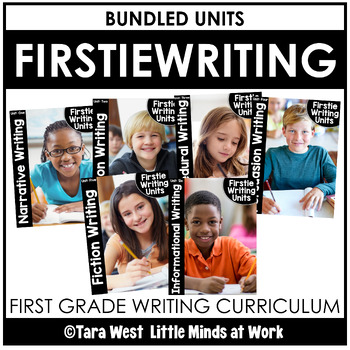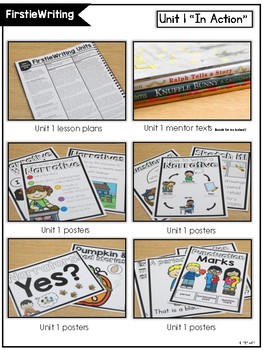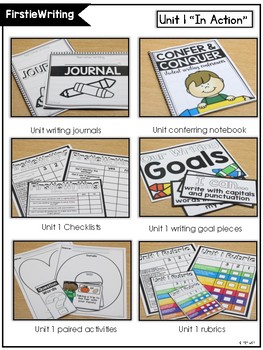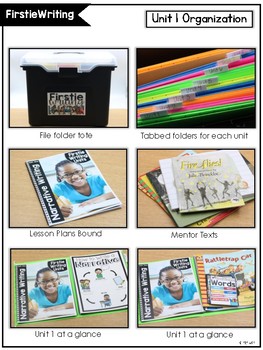FirstieWriting: First Grade and 2nd Grade Writing Curriculum Bundle
- Zip
What educators are saying
Products in this Bundle (6)
showing 1-5 of 6 products
Description
FirstieWriting Curriculum Units BUNDLED is an engaging, standards-based first grade (and Second Grade), genre-based writing curriculum.
SAVE $10 ON THE BUNDLE!
6 units @ $15 each = $90
The bundle will increase in price each time a new unit is added! Snag it now to save!
Do you have a few extra moments? Watch a detailed video about this curriculum HERE!
What is FirstieWriting?
FirstieWriting Curriculum is an engaging, first grade (and Second Grade), genre-based writing curriculum. FirstieWriting encourages young learners to look inward at their endless possibilities as a writer. FirstieWriting is based upon six units: Writing With Narrative, Writing With Opinion, Writing With Direction, Writing With Persuasion, Writing With Imagination, and Writing With Information. Each unit is broken down to 30 lessons. The units cover 30 days of academic instruction. The lesson plans have listed unit objectives, “I can” statements, Common Core writing standards and needed mentor texts.
**Special note that this packet is branded with the 'Firstie' name. However, this program is completely appropriate for second grade students as well! No student material is branded with the 'firstie' logo so it can be easily used in 1st, 2nd, or multi-age classrooms!**
FirstieWriting encourages a daily routine of a minilesson, independent writing, and a share time. Each of the lessons in FirstieWriting are well thought out for the young writer and spiral back to previous lessons to ensure students are retaining their skills. FirstieWriting also includes unit anchor charts, a variety of writing paper, conferring schedules and note sheets, sample writings, student writing goals display, writing rubrics, and step-by-step guides that are made specifically for each unit. Below is a look at the lessons included in the unit.
What is included in FirstieWritring Curriculum?
-Teacher "simple read" lesson plans. You will not need to rewrite these lesson plans, unless you choose do. If so I have included editable lesson plans.
-Each unit I have planned out the; big idea, focus standard, essential questions, and so much more!
-Writing paper
-Unit posters
-Student material
-Unit rubrics
What Units are Covered?
Unit 1 Narrative Writing INCLUDED NOW
Unit 2 Opinion Writing INCLUDED NOW
Unit 3 Procedural Writing INCLUDED NOW
Unit 4 Persuasion Writing INCLUDED NOW
Unit 5 Fiction Writing INCLUDED NOW
Unit 6 Informational Writing INCLUDED NOW
What lessons are included?
Lesson 1: Pre-Assessment
Lesson 2: Stories Are Everywhere
Lesson 3: Help! I Don’t Have a Story
Lesson 4: Let’s Make a Plan
Lesson 5: Sketch It
Lesson 6: Keep on Writing
Lesson 7: Adding Details to Pictures
Lesson 8: Stay Focused to the End
Lesson 9: Spelling is a Snap I
Lesson 10: Mechanics Matter
Lesson 11: Read Like a Storyteller
Lesson 12: Let’s Begin Again
Lesson 13: Setting- Where and When
Lesson 14: Make Characters Move
Lesson 15: Characters Talk- Dialogue
Lesson 16: Mid Unit Check
Lesson 17: Characters Feel and Think
Lesson 18: Building Suspense
Lesson 19: Spelling is a Snap II
Lesson 20: Transitional Words
Lesson 21: Ellipses
Lesson 22: Sound Effects - Pop Out Words
Lesson 23: Storytelling With a Partner
Lesson 24: Let’s Begin Again
Lesson 25: Use All You Know I
Lesson 26: Use All You Know II
Lesson 27: Let’s Revise
Lesson 28: Let’s Edit
Lesson 29: Meet the Author
Lesson 30: Celebration
Unit Two: Opinion Writing
Lesson 1: Pre-Assessment
Lesson 2: We All Have Opinions
Lesson 3: Fact vs. Opinion
Lesson 4: Giving Reasons
Lesson 5: Convince Your Reader
Lesson 6: Hook Them In
Lesson 7: Closure
Lesson 8: Put It All Together
Lesson 9: Spelling is a Snap I
Lesson 10: Mechanics Matter
Lesson 11: Read Like a Storyteller
Lesson 12: Let’s Begin Again
Lesson 13: Elaborate
Lesson 14: Use Dialogue
Lesson 15: It’s Okay to Disagree
Lesson 16: Mid Unit Check
Lesson 17: Setting Writing Goals
Lesson 18: Would You Rather...
Lesson 19: Spelling is a Snap II
Lesson 20: Let’s Begin Again
Lesson 21: Convince Me
Lesson 22: Putting it All Together
Lesson 23: Storytelling with a Partner
Lesson 24: Let’s Begin Again
Lesson 25: Use All You Know I
Lesson 26: Use All You Know II
Lesson 27: Let’s Revise
Lesson 28: Let’s Edit
Lesson 29: Meet the Author
Lesson 30: Celebration
Unit Three: Procedural Writing
Lesson 1: Pre-Assessment
Lesson 2: Exploring Procedural Writing
Lesson 3: Things We Know How To…
Lesson 4: Order Matters
Lesson 5: Let’s Make a Plan
Lesson 6: Sketch It!
Lesson 7: Write It Out – Step-by-Step
Lesson 8: Time Order
Lesson 9: Spelling is a Snap I
Lesson 10: Mechanics Matter
Lesson 11: Don’t Get Confused
Lesson 12: Let’s Begin Again
Lesson 13: Introduction
Lesson 14: Step-by-Step
Lesson 15: Adding Labels
Lesson 16: Mid Unit Check
Lesson 17: Setting Writing Goals
Lesson 18: Partner Talk!
Lesson 19: Spelling is a Snap II
Lesson 20: Giving Readers Suggestions
Lesson 21: Use Exact Vocabulary
Lesson 22: Wrap It Up
Lesson 23: Test It Out
Lesson 24: Let’s Begin Again
Lesson 25: Use All You Know I
Lesson 26: Use All You Know II
Lesson 27: Let’s Revise
Lesson 28: Let’s Edit
Lesson 29: Meet the Author
Lesson 30: Celebration
Lesson 1: Pre-Assessment
Lesson 2: What is Persuasion?
Lesson 3: Fact vs. Opinion
Lesson 4: Giving Reasons
Lesson 5: Convince Your Reader
Lesson 6: Hook Them In
Lesson 7: Closure
Lesson 8: Put It All Together
Lesson 9: Spelling is a Snap I
Lesson 10: Mechanics Matter
Lesson 11: Read Like a Storyteller
Lesson 12: Let’s Begin Again
Lesson 13: Elaborate!
Lesson 14: Use Dialogue
Lesson 15: Mid-Unit Check
Lesson 16: Setting Writing Goals
Lesson 17: Hey Little Ant!
Lesson 18: Spelling is a Snap II
Lesson 19: Let’s Begin Again!
Lesson 20: Convince Me
Lesson 21: Sneak Peek!
Lesson 22: Remember a Time…
Lesson 23: Recommendation
Lesson 24: Let’s Begin Again
Lesson 25: Use All You Know I
Lesson 26: Use All You Know II
Lesson 27: Let’s Revise
Lesson 28: Let’s Edit
Lesson 29: Meet the Author
Unit Five: Fiction Writing
Lesson 1: Pre-Assessment
Lesson 2: What is Realistic Fiction?
Lesson 3: Help! I Don’t Know What to Write
Lesson 4: Let’s Make a Plan
Lesson 5: Sketch It
Lesson 6: Keep on Writing
Lesson 7: Adding Details to Pictures
Lesson 8: Stay Focused to the End
Lesson 9: Spelling is a Snap I
Lesson 10: Mechanics Matter
Lesson 11: Read Like a Storyteller
Lesson 12: Let’s Begin Again
Lesson 13: Where and When
Lesson 14: Make Characters Move
Lesson 15: Characters Talk- Dialogue
Lesson 16: Building Suspense
Lesson 17: Mid-Unit Check
Lesson 18: Setting Writing Goals
Lesson 19: Spelling is a Snap II
Lesson 20: Transition Words
Lesson 21: Repeated Phrases
Lesson 22: Sound Effects/Pop Out Words
Lesson 23: Storytelling with a Partner
Lesson 24: Let’s Begin Again
Lesson 25: Use All You Know I
Lesson 26: Use All You Know II
Lesson 27: Let’s Revise
Lesson 28: Let’s Edit
Lesson 29: Meet the Author
Lesson 30: Celebration
Unit Six: Nonfiction Writing
Lesson 1: Pre-Assessment
Lesson 2: What is Informative Writing?
Lesson 3: Gather Up Facts
Lesson 4: Plan it Out
Lesson 5: Introduction
Lesson 6: Text Feature: Diagram
Lesson 7: Text Feature: Headings
Lesson 8: Closure
Lesson 9: Spelling is a Snap I
Lesson 10: Mechanics Matter
Lesson 11: Be the Expert!
Lesson 12: Let’s Begin Again
Lesson 13: Writing Strong Facts
Lesson 14: Audience
Lesson 15: Zooming In
Lesson 16: Mid-Unit Check
Lesson 17: Setting Writing Goals
Lesson 18: Spelling is a Snap II
Lesson 19: Partner Talk!
Lesson 20: Teaching Comparisons
Lesson 21: Use Exact Vocabulary
Lesson 22: Text Feature: Glossary
Lesson 23: Text Feature: Table of Contents
Lesson 24: Let’s Begin Again
Lesson 25: Use All You Know I
Lesson 26: Use All You Know II
Lesson 27: Let’s Revise
Lesson 28: Let’s Edit
Lesson 29: Meet the Author
Lesson 30: Celebration
BIG Idea and Research - First Grade Writing
Writing is one of the hardest subjects to teach in a primary classroom. Teachers strive to model lessons, differentiate lessons, and conference with each student on a daily basis in a classroom where every student is at a different level and ability. Although each student will be at a different level, they come to you as young writers ready to grow leap and bounds. FirstieWriting Units continue to build on the energy and knowledge students learned in Kindergarten.
In first grade, we strive to turn students into writers by modeling a love of writing and having an emphasis on a daily writing time in which students engage in the writing process. In Children Want to Write edited by Tom Newkirk and Penny Kittle (2013) Donald Graves is quoted as saying, “when students write every day, they begin to compose even when they are not composing. They enter into a constant state of composition” (p. 58). Research conducted by Hattie and Gladwell both concluded that there is a direct correlation between the amount of time we spend in pursuit of a habit, goal or skill and our individual growth in relation to that habit, goal or skill. In other words, for students to improve as writers, and build stamina, it is important for them to have long stretches of writing time that occur on a daily basis.
Within each writing unit, conferencing with students happens every day. Small group work and conferencing with students is one of the most important parts in the writer’s workshop. Conferring is working one-on-one, or in a small group setting, with a student to listen and understand a child’s work and intentions. The teacher also provides effective feedback to make sure the learner is working with direction. Learning progressions and student checklists are important tools that promote self-assessment and goal setting so instruction can be differentiated to each individual learner. For any learner to grow stronger, the learner must be provided with informative, responsive feedback. Hattie’s (2008) research revealed feedback is especially valuable if the teacher helps the learner know where he is going, what progress he has made so far, and what specific activities he can do next to progress towards the goal. Calkins (1994) believes “perfect practice makes perfect,” which means that students need long stretches of time, along with specific feedback aligned to next steps for them as writers, in order to progress.
Mentor texts are used throughout each writing unit. Students benefit from examples and one of the most effective ways to teach writing is to use mentor texts. By looking at examples of good writing, especially in published work, students learn to aspire to create effective pieces of their own.
What about the standards?
Each unit has a focus standard that is based upon the Common Core Standards. Units further into the year will have more than one focus standard. If you teach to a varying set of standards, you can email me for assistance. Thanks!
Do you teach Kindergarten? I have a writing curriculum for YOU! View my KinderWriting HERE!
If you have any questions at all about this packet please email me at littlemindsatworkllc@gmail.com
Visit my blog Little Minds at Work
Follow me on Facebook
RAKB2B





